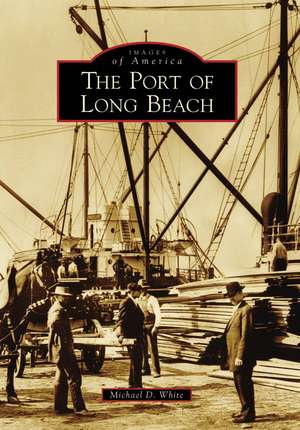The Port of Long Beach: Images of America (Arcadia Publishing)
Autor Michael D. Whiteen Limba Engleză Paperback – 31 ian 2009
Din seria Images of America (Arcadia Publishing)
-
 Preț: 129.71 lei
Preț: 129.71 lei -
 Preț: 129.71 lei
Preț: 129.71 lei -
 Preț: 130.74 lei
Preț: 130.74 lei -
 Preț: 129.71 lei
Preț: 129.71 lei -
 Preț: 125.22 lei
Preț: 125.22 lei -
 Preț: 130.74 lei
Preț: 130.74 lei -
 Preț: 130.74 lei
Preț: 130.74 lei -
 Preț: 130.92 lei
Preț: 130.92 lei -
 Preț: 132.42 lei
Preț: 132.42 lei -
 Preț: 115.50 lei
Preț: 115.50 lei -
 Preț: 130.97 lei
Preț: 130.97 lei -
 Preț: 129.49 lei
Preț: 129.49 lei -
 Preț: 115.72 lei
Preț: 115.72 lei -
 Preț: 126.07 lei
Preț: 126.07 lei -
 Preț: 131.55 lei
Preț: 131.55 lei -
 Preț: 127.30 lei
Preț: 127.30 lei -
 Preț: 115.72 lei
Preț: 115.72 lei -
 Preț: 131.16 lei
Preț: 131.16 lei -
 Preț: 126.26 lei
Preț: 126.26 lei -
 Preț: 132.42 lei
Preț: 132.42 lei -
 Preț: 130.97 lei
Preț: 130.97 lei -
 Preț: 130.97 lei
Preț: 130.97 lei -
 Preț: 129.71 lei
Preț: 129.71 lei -
 Preț: 126.26 lei
Preț: 126.26 lei -
 Preț: 130.97 lei
Preț: 130.97 lei -
 Preț: 126.26 lei
Preț: 126.26 lei -
 Preț: 131.79 lei
Preț: 131.79 lei -
 Preț: 118.36 lei
Preț: 118.36 lei -
 Preț: 125.22 lei
Preț: 125.22 lei -
 Preț: 126.67 lei
Preț: 126.67 lei -
 Preț: 130.74 lei
Preț: 130.74 lei -
 Preț: 135.25 lei
Preț: 135.25 lei -
 Preț: 132.18 lei
Preț: 132.18 lei -
 Preț: 116.31 lei
Preț: 116.31 lei -
 Preț: 130.97 lei
Preț: 130.97 lei -
 Preț: 132.18 lei
Preț: 132.18 lei -
 Preț: 130.92 lei
Preț: 130.92 lei -
 Preț: 131.15 lei
Preț: 131.15 lei -
 Preț: 131.15 lei
Preț: 131.15 lei -
 Preț: 130.74 lei
Preț: 130.74 lei -
 Preț: 130.97 lei
Preț: 130.97 lei -
 Preț: 130.97 lei
Preț: 130.97 lei -
 Preț: 130.74 lei
Preț: 130.74 lei -
 Preț: 131.15 lei
Preț: 131.15 lei -
 Preț: 130.75 lei
Preț: 130.75 lei -
 Preț: 130.97 lei
Preț: 130.97 lei -
 Preț: 127.08 lei
Preț: 127.08 lei -
 Preț: 129.71 lei
Preț: 129.71 lei -
 Preț: 176.03 lei
Preț: 176.03 lei -
 Preț: 116.13 lei
Preț: 116.13 lei
Preț: 134.62 lei
Nou
Puncte Express: 202
Preț estimativ în valută:
25.77€ • 26.50$ • 21.38£
25.77€ • 26.50$ • 21.38£
Carte indisponibilă temporar
Doresc să fiu notificat când acest titlu va fi disponibil:
Se trimite...
Preluare comenzi: 021 569.72.76
Specificații
ISBN-13: 9780738569857
ISBN-10: 0738569852
Pagini: 127
Dimensiuni: 163 x 231 x 10 mm
Greutate: 0.38 kg
Editura: Arcadia Publishing (SC)
Seria Images of America (Arcadia Publishing)
ISBN-10: 0738569852
Pagini: 127
Dimensiuni: 163 x 231 x 10 mm
Greutate: 0.38 kg
Editura: Arcadia Publishing (SC)
Seria Images of America (Arcadia Publishing)
Descriere
Rising from a tidal mudflat at the mouth of the Los Angeles River, the Port of Long Beach has grown through the 20th century into the one of the busiest deepwater ports. The ultramodern Port of Long Beach, the second-largest active harbor in the United States in the first decade of the 21st century, progressed steadily through a difficult adolescence fueled by the ambitions of a visionary few local community leaders who overcame political opposition to create a port separate and distinct from its neighboring Port of Los Angeles. Fueled by oil, Southern Californiaas unprecedented postaWorld War II growth, and the container revolution, the Port of Long Beach surmounted numerous natural and man-made hurdles to position itself, in its own right, as a critical link in the nationas global supply chain.
Recenzii
Title: On the Waterfront: New book pictures the LB Port of old
Author: Kris Hanson
Publisher: Press Telegram
Date: 2/9/2009
The year was 1954, and the Port of Long Beach was enjoying one of its occasional trade booms - those prosperous periods when docks overflow with goods and everyone is making money.
Sometime that summer, an unidentified photographer snapped an image as hundreds of shiny new Nash Metropolitans lined up at a marine terminal awaiting shipment overseas.
In the hazy background sits a long-demolished warehouse, and further on, a water tower, also extinct.
Noticeably absent from the frame are any of the massive cranes that now dominate the port's landscape. This was, after all, a few years before containerization forever changed global trade in the early 1960s.
The iconic photo is one of several hundred historical images captured in author Michael White's new book "Images of America: The Port of Long Beach," released Monday.
Throughout the 128-page visual tour, White's compiled an impressive photo essay providing glimpses and insights into the evolution of America's second-largest seaport.
There's also extensive insight accompanying the images, including little-known tales of how anti-growth politicians and community groups nearly killed the port during its infancy in the early part of the 20th century.
Using images from his own collection, the port and Long Beach Public Library, the book documents all phases of port growth from 1906 onward. Included are numerous photos of early harbor pioneers like Long Beach Mayor Charles Windham and cigar-chomping harbor manager Eloi "Frenchy" Amar, who held the port'stop post for 19 eventful years.
Well-documented is the harbor's long struggle with subsidence caused by oil extraction - a problem that caused hundreds of acres of port property to sink as much as 24 feet, including harbor headquarters in one especially memorable photo on Page 81.
Equally compelling are images depicting the changing nature of global trade through San Pedro Bay, from early reliance on lumber, oranges and cotton to the modern era's dependence on furniture, electronics, toys and oil.
There are even photos of laborers dropping rocks into the ocean during construction of the much-maligned breakwater, which conservationists and city boosters are now trying to remove in an effort to clean up the harbor and restore wave action to the city's shoreline.
White, a longtime area journalist, has extensive history in maritime trade in Southern California, working for publications like the now-defunct Los Angeles Daily Economic Report and Shipping Guide and Pacific Shipper, as well as in public relations for Mitsui-OSK shipping.
White said most of the book's photographs have never been published.
"One of the things that became evident while I was researching for the book was that while the Port of Long Beach was long considered the cross-eyed sister of the Port of Los Angeles, it really came into its own and became a national player alongside L.A. as the region and nation's economy grew, say, after containerization," White said. "The two ports together became America's trade gateway to the rest of the world, not L.A. alone."
Published one year after a similar photo-essay on the Port of Los Angeles, White's book is a must for SouthernCalifornia history buffs, dockworkers, educators, students and anyone interested in the Long Beach waterfront's colorful past.
The book, offered at $21.99, is available at area bookstores, independent retailers and online, or through publisher Arcadia Publishing at 888-313-2665 or www.arcadiapublishing.com.
Author: Kris Hanson
Publisher: Press Telegram
Date: 2/9/2009
The year was 1954, and the Port of Long Beach was enjoying one of its occasional trade booms - those prosperous periods when docks overflow with goods and everyone is making money.
Sometime that summer, an unidentified photographer snapped an image as hundreds of shiny new Nash Metropolitans lined up at a marine terminal awaiting shipment overseas.
In the hazy background sits a long-demolished warehouse, and further on, a water tower, also extinct.
Noticeably absent from the frame are any of the massive cranes that now dominate the port's landscape. This was, after all, a few years before containerization forever changed global trade in the early 1960s.
The iconic photo is one of several hundred historical images captured in author Michael White's new book "Images of America: The Port of Long Beach," released Monday.
Throughout the 128-page visual tour, White's compiled an impressive photo essay providing glimpses and insights into the evolution of America's second-largest seaport.
There's also extensive insight accompanying the images, including little-known tales of how anti-growth politicians and community groups nearly killed the port during its infancy in the early part of the 20th century.
Using images from his own collection, the port and Long Beach Public Library, the book documents all phases of port growth from 1906 onward. Included are numerous photos of early harbor pioneers like Long Beach Mayor Charles Windham and cigar-chomping harbor manager Eloi "Frenchy" Amar, who held the port'stop post for 19 eventful years.
Well-documented is the harbor's long struggle with subsidence caused by oil extraction - a problem that caused hundreds of acres of port property to sink as much as 24 feet, including harbor headquarters in one especially memorable photo on Page 81.
Equally compelling are images depicting the changing nature of global trade through San Pedro Bay, from early reliance on lumber, oranges and cotton to the modern era's dependence on furniture, electronics, toys and oil.
There are even photos of laborers dropping rocks into the ocean during construction of the much-maligned breakwater, which conservationists and city boosters are now trying to remove in an effort to clean up the harbor and restore wave action to the city's shoreline.
White, a longtime area journalist, has extensive history in maritime trade in Southern California, working for publications like the now-defunct Los Angeles Daily Economic Report and Shipping Guide and Pacific Shipper, as well as in public relations for Mitsui-OSK shipping.
White said most of the book's photographs have never been published.
"One of the things that became evident while I was researching for the book was that while the Port of Long Beach was long considered the cross-eyed sister of the Port of Los Angeles, it really came into its own and became a national player alongside L.A. as the region and nation's economy grew, say, after containerization," White said. "The two ports together became America's trade gateway to the rest of the world, not L.A. alone."
Published one year after a similar photo-essay on the Port of Los Angeles, White's book is a must for SouthernCalifornia history buffs, dockworkers, educators, students and anyone interested in the Long Beach waterfront's colorful past.
The book, offered at $21.99, is available at area bookstores, independent retailers and online, or through publisher Arcadia Publishing at 888-313-2665 or www.arcadiapublishing.com.
Notă biografică
Business editor and author Michael D. White researched these images, many of which have never been published before, from a number of sources including his own collection of maritime photographs, the archives of the Long Beach Public Library, and the extensive accumulation of historic photographs and materials maintained by the Port of Long Beach. This book is a companion to his previous book with Arcadia Publishing, The Port of Los Angeles.











